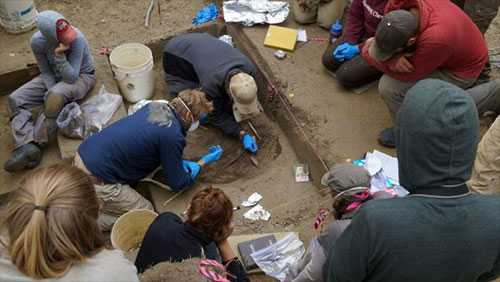
Study determines early Interior Alaskans had complex, diverse dietsBy JEFF RICHARDSON
September 05, 2020
The University of Alaska Fairbanks-led study analyzed the chemical composition of bones and teeth from two Ancient Beringian infants. Stable isotope analysis of human tissues can directly reveal the foods consumed by individuals, in this case their mothers’ diets during pregnancy. The infant remains, dated to about 11,500 years ago, were discovered at the Upward Sun River archaeological site in Alaska’s Tanana Valley. The study represents the first comprehensive isotopic diet analysis of Ice Age Native Americans.
The findings were published yesterday in the journal Science Advances. The diets of Ice Age Native Americans have sometimes been portrayed with either a focus on hunting large animals or general foraging. However, although ancient Alaskans’ diets were dominated by large animals like bison, isotope analysis shows the summer diet also included salmon. Those results are consistent with other evidence, including animal bones found at archaeological sites and chemical analysis of ancient hearths. “Our results demonstrate that ancient Alaskan diets were complex and seasonally structured, and that salmon has been an important resource for people in central Alaska for thousands of years,” said Carrin Halffman, an affiliate professor with UAF’s Department of Anthropology and co-lead author of the paper. The research was done in cooperation and consultation with the Healy Lake Tribe and Tanana Chiefs Conference, a consortium of Interior Alaska tribes. Ben Potter, with the Arctic Studies Center at Liaocheng University, is co-author of the paper. Other UAF contributors include Holly McKinney, Matthew Wooller, Casey Clark, Jessica Johnson, Joshua Reuther, and François B. Lanoë, who is also affiliated with the University of Arizona. Contributors from other institutions include Takumi Tsutaya, Japan Agency for Marine-Earth Science and Technology; Bruce Finney, Idaho State University; Brian Kemp and Brittany Bingham, University of Oklahoma; Eric Bartelink, California State University, Chico; Michael Buckley, University of Manchester; and Robert Sattler, Tanana Chiefs Conference.
On the Web:
|
|||||
